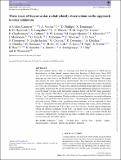Three years of Sun-as-a-star radial-velocity observations on the approach to solar minimum
Abstract
The time-variable velocity fields of solar-type stars limit the precision of radial-velocity determinations of their planets’ masses, obstructing detection of Earth twins. Since 2015 July, we have been monitoring disc-integrated sunlight in daytime using a purpose-built solar telescope and fibre feed to the HARPS-N stellar radial-velocity spectrometer. We present and analyse the solar radial-velocity measurements and cross-correlation function (CCF) parameters obtained in the first 3 yr of observation, interpreting them in the context of spatially resolved solar observations. We describe a Bayesian mixture-model approach to automated data-quality monitoring. We provide dynamical and daily differential-extinction corrections to place the radial velocities in the heliocentric reference frame, and the CCF shape parameters in the sidereal frame. We achieve a photon-noise-limited radial-velocity precision better than 0.43 m s−1 per 5-min observation. The day-to-day precision is limited by zero-point calibration uncertainty with an RMS scatter of about 0.4 m s−1. We find significant signals from granulation and solar activity. Within a day, granulation noise dominates, with an amplitude of about 0.4 m s−1 and an autocorrelation half-life of 15 min. On longer time-scales, activity dominates. Sunspot groups broaden the CCF as they cross the solar disc. Facular regions temporarily reduce the intrinsic asymmetry of the CCF. The radial-velocity increase that accompanies an active-region passage has a typical amplitude of 5 m s−1 and is correlated with the line asymmetry, but leads it by 3 d. Spectral line-shape variability thus shows promise as a proxy for recovering the true radial velocity.
Citation
Cameron , A C , Mortier , A , Phillips , D , Dumusque , X , Haywood , R D , Langellier , N , Watson , C A , Cegla , H M , Costes , J , Charbonneau , D , Coffinet , A , Latham , D W , Lopez-Morales , M , Malavolta , L , Maldonado , J , Micela , G , Milbourne , T , Molinari , E , Saar , S H , Thompson , S , Buchschacher , N , Cecconi , M , Cosentino , R , Ghedina , A , Glenday , A , Gonzalez , M , Li , C -H , Lodi , M , Lovis , C , Pepe , F , Poretti , E , Rice , K , Sasselov , D , Sozzetti , A , Szentgyorgyi , A , Udry , S & Walsworth , R 2019 , ' Three years of Sun-as-a-star radial-velocity observations on the approach to solar minimum ' , Monthly Notices of the Royal Astronomical Society , vol. 487 , no. 1 , pp. 1082–1100 . https://doi.org/10.1093/mnras/stz1215
Publication
Monthly Notices of the Royal Astronomical Society
Status
Peer reviewed
ISSN
0035-8711Type
Journal article
Collections
Items in the St Andrews Research Repository are protected by copyright, with all rights reserved, unless otherwise indicated.

